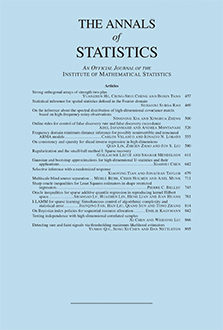Abstract
We study the rank of the instantaneous or spot covariance matrix of a multidimensional process . Given high-frequency observations , , we test the null hypothesis for all t against local alternatives where the average st eigenvalue is larger than some signal detection rate .
A major problem is that the inherent averaging in local covariance statistics produces a bias that distorts the rank statistics. We show that the bias depends on the regularity and spectral gap of . We establish explicit matrix perturbation and concentration results that provide nonasymptotic uniform critical values and optimal signal detection rates . This leads to a rank estimation method via sequential testing. For a class of stochastic volatility models, we determine data-driven critical values via normed p-variations of estimated local covariance matrices. The methods are illustrated by simulations and an application to high-frequency data of U.S. government bonds.
Acknowledgments
We are grateful for helpful discussions with Mark Podolskij, Taras Bodnar and Markus Bibinger as well as for stimulating comments by anonymous referees, the Associate Editor and the Editor.
Citation
Markus Reiss. Lars Winkelmann. "Inference on the maximal rank of time-varying covariance matrices using high-frequency data." Ann. Statist. 51 (2) 791 - 815, April 2023. https://doi.org/10.1214/23-AOS2273
Information





